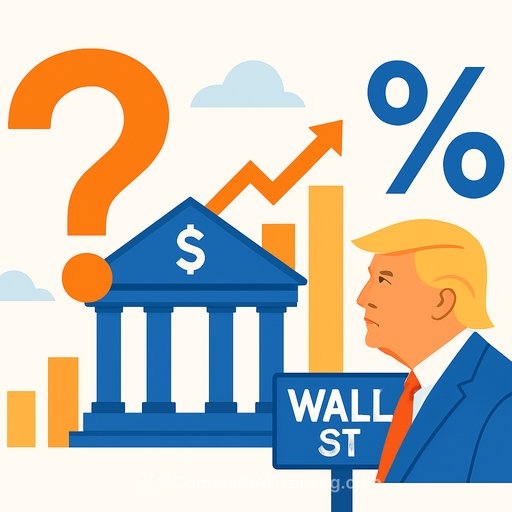Rates, Rules, and the Next Leg of the Cycle
Markets are converging on a path where the Federal Reserve cuts its policy rate toward 4% in the coming months. That glide path now faces a new variable: a push to loosen U.S. financial regulations that could substitute for some portion of monetary easing.
If deregulation lifts bank lending at scale, the economy could get easier credit conditions without as many rate cuts. That would reshape the risk-reward for banks, credit markets, and rate-sensitive equities heading into Q3 earnings.
Deregulation as a Substitute for Rate Cuts
According to research cited by the Financial Times, easing post-crisis rules could unlock up to $2.6 trillion in U.S. lending capacity, largely at top-tier banks. The same analysis estimates roughly $140 billion in immediate capital relief for large lenders.
The mechanism is direct: lower capital and liquidity constraints expand balance sheet capacity, reduce funding frictions, and encourage risk-weighted asset growth. For growth that's slowing but not stalling, that's functionally similar to easing-just delivered through the regulatory channel rather than the policy rate.
Earnings Math: Who Benefits
Modeling from street analysts points to a potential 14% reduction in Tier 1 capital requirements under a looser regime. That translates to an estimated 35% boost to EPS and roughly a 6% lift to return on average tangible common equity for U.S. banks, assuming redeployment into higher-yielding assets and resumed buybacks.
J.P. Morgan Chase (JPM) could be a prime beneficiary, with a projected ~$40 billion real-terms capital release and an EPS lift near 31%. Morgan Stanley (MS) and Goldman Sachs (GS) would also benefit from greater market-making and balance sheet flexibility. Meanwhile, European peers such as BNP Paribas (BNP), Deutsche Bank (DB), and UBS (UBS) could lag if the competitive gap in capital intensity widens.
The Post-Crisis Constraint Being Rewritten
Much of the debate centers on the Dodd-Frank framework, which strengthened capital and liquidity standards after 2008. Critics argue it constrained bank credit and shifted risk to private markets.
Voices aligned with a deregulatory agenda want to loosen key elements of those rules-effectively trading some solidity for liquidity. Michelle Bowman, a known critic of tighter capital standards, has been vocal on the burden of post-crisis rules and their impact on credit supply.
Central Bankers' Caution
Global officials are urging restraint. ECB President Christine Lagarde has cautioned against rolling back safeguards too far. Bank of England Governor Andrew Bailey warned against "throwing the baby out with the bathwater," while BoE officials flagged the risk of an AI-driven asset bubble given shaky revenue support.
With major capex flowing into AI infrastructure, data centers, and IoT, policy choices now sit at the junction of growth ambitions and financial stability. Looser rules could accelerate capex financing-alongside higher cyclical and market risk if underwriting standards slip.
Why Q3 Bank Earnings Matter
Next week's bank earnings are a live test of this thesis. If management teams signal confidence in softer rules and a willingness to expand credit, the Fed's urgency to cut could ease. If they sound defensive-tightening lending standards and hoarding capital-rate cuts regain center stage.
- Lending stance: C&I appetite, CRE exposure, consumer credit lines, and underwriting shifts
- Balance sheet: RWA trajectories, deposit beta, securities book duration, and OCI sensitivity
- Capital return: Buyback cadence, dividend signals, and buffer targets under different rule paths
- Credit quality: Card delinquencies/roll rates, CRE office charge-offs, reserve builds under CECL
- Market businesses: FICC/Equities VaR, balance sheet usage, and pipeline color
Trading and Allocation Implications
- Rates: A credible deregulation path plus "soft landing" data argues for a stickier policy rate floor and a steeper curve. Watch term premium and breakevens.
- Banks: U.S. large-cap banks could re-rate on EPS upgrades and buyback optionality. Regulatory clarity is the catalyst; execution on RWA growth is the follow-through.
- Credit: Potentially tighter U.S. bank senior spreads; monitor supply dynamics if balance sheet growth resumes. Private credit could face tougher competition on price and terms.
- Equities: If credit eases without deeper cuts, cyclicals and financials gain relative to long-duration tech. If earnings tone is cautious, duration resumes leadership.
- FX: A less dovish Fed path supports the dollar; watch policy-rate differentials and front-end repricing.
Key Risks to the Bull Case
- Policy whiplash: Political or legal hurdles slow or dilute rule changes, leaving banks in limbo and muting the EPS uplift.
- Credit cycle turn: Consumer stress (cards, autos) or CRE losses force higher reserves, absorbing any capital relief.
- Asset bubble unwind: If AI-linked valuations correct without earnings support, risk appetite fades and lending standards tighten.
- Funding pressure: Elevated deposit beta or wholesale funding costs cap NIM expansion even as RWAs grow.
What to Do Now
- Build two scenarios-"Rule Relief" vs. "Status Quo." Tie each to rate paths, bank EPS, buybacks, and sector rotation.
- Re-underwrite bank models: Update capital buffers, RWA density, and payout ratios under lighter constraints.
- Watch early indicators: Lending standards (SLOOS), deposit migration, credit card vintage performance, CRE office marks.
- Stay nimble around earnings: Position for dispersion within U.S. banks; skew to names with balance sheet flexibility and clear buyback triggers.
Bottom Line
The next leg of policy easing may come from regulators, not just the Fed. If banks confirm a willingness to expand credit on earnings calls, rate cuts could arrive slower and in smaller steps-while bank EPS arrives faster.
If the tone is cautious, the market reverts to expecting deeper cuts. Either way, positioning ahead of Q3 earnings is less about guessing the next 25 bps, and more about mapping how rules, credit, and capital returns will intersect in 2025.
Resource: For teams analyzing AI capex and sector exposure, here's a curated list of AI tools for finance to speed up research and monitoring.
Your membership also unlocks:





